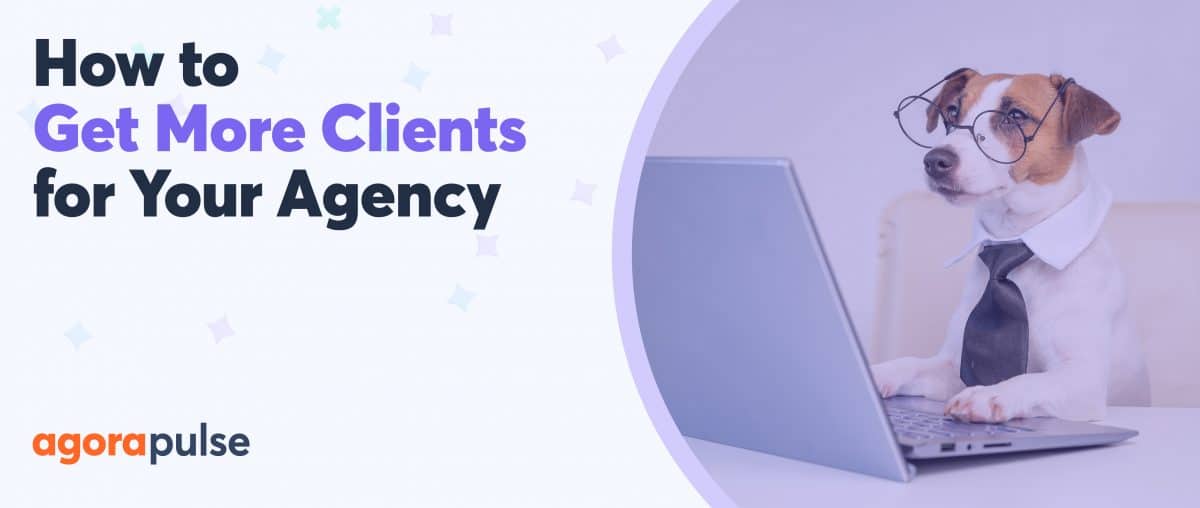Everyone wants to scale their agency. But no one wants to manage more people. After all, managing people wasn’t the reason you got into the agency game, was it?
You love winning new clients. You love the variety of cool tools you get to use. And above all else, you love getting results for your clients. That’s what drives you.
Not managing more people, complexity, and politics.
But surely, the only way to grow your agency is to employ more people. The more bottoms on seats, the more clients you can secure, and the more you can handle the increased workloads, pressures, and deadlines, right?
During last year’s Agorapulse’s Agency Summit, Chris Rudolph, founder of The Freedom Agency Coach, introduced an alternative way for agencies to grow their revenue without having to grow their teams.
Say hello to the performance retainer.
Want to know how a performance retainer can double your revenue and double the ROI for your clients, without doubling your workforce? Read the summary of his Agency Summit talk below.
If you want to join this year’s Agency Summit on Thursday, August 25, sign up now. It’s the industry’s biggest ever summit. We’ve got industry leaders, break-out sessions, expo halls, networking opportunities, keynote speakers, and more. If you’re an agency, you don’t want to miss this, so join now.
What Is a Performance Retainer?
A performance retainer is a combination of two common agency billing models:
- The flat-rate retainer
- The pay-for-performance package
Instead of billing a client once a month, on either a flat-rate or a pay-for-performance basis, a performance retainer allows you to bill your clients twice: Once, at the beginning of the month, as a flat-rate retainer, and a second time, halfway through the following month, on a performance-based package.
The flat-rate retainer part means that the workload and cash flow are spread out over the course of the month, which alleviates the risk that comes with using a pay-for-performance model.
The performance-based part allows room for maximum revenue growth, which you don’t get with a flat-rate retainer model.
A performance retainer gets the best out of both billing models and will enable you to double your revenue, without having to double your team.
But that’s not the only great part of having a performance retainer.
Reasons for Using a Performance Retainer
Performance retainers are more resilient to economic downturns than flat-rate retainers and pay-for-performance packages are.
Think about it: If you’re billing a client $7,000 per month on a flat-rate retainer, and something major hits, like a pandemic or a recession, it will create financial uncertainty for your client. Your services might be the first to get cut. And if your client is on a pay-for-performance package, you’ll also face a period of uncertainty as the economy fluctuates.
But if you were to offer your client a performance retainer, where you offer them a low fixed-rate retainer while also billing them for your performance, this will improve cash flow for both you and your client during the unsettled time.
You get paid twice, and they aren’t landed with an overwhelming bill at the start of every month.
Everybody wins.
Plus, this strategy will also help you to keep your retainer rates at a premium.
Ever worked with a small brand or a start-up that has great potential but can’t afford the higher retainer rates yet? You might consider discounting your retainer fees, just to get them onto your books, right? But how hard is it to raise your rates at a later date, though?
If you offer them a performance retainer, your retainer fees will be lower because you’re getting paid for performance too. So, they can afford you, and you don’t need to discount your rates. Again, everyone’s a winner.
But, like blue cheese, a performance retainer isn’t for everyone.
Is a Performance Retainer Right for You?
You have to be able to cope with the ups and downs that performance-based billing brings. But if you want long-term, sustainable growth, you should be building a performance retainer into your billing strategy.
Ask yourself the following five questions. (If you can answer yes to all five, chances are, a performance retainer will work for your agency.)
- Can you secure a good ROI for your clients?
- Do you offer a suite of services?
- Do you speak to start-ups or smaller brands that have big growth potential but can’t afford your premium retainer prices yet?
- Do you have shoulders big enough to carry the weight of the ups and downs that come with performance-based billing?
- Do you have the guts to have some difficult performance conversations with clients and your team when needed?
If you’ve established that a performance retainer is the right billing model for your agency, you can start building your package.
How to Build Your Performance Retainer Package in 5 Easy Steps
Performance retainer package step 1
Clarify the outcome you want to deliver for your ideal client.
Performance retainer package step 2
Determine what services you need to offer to be able to deliver that outcome.
Top tip: Don’t be afraid to team up with contractors or other agencies to broaden your service stack. Keep adding additional services to your repertoire as your agency grows and you take on a wider variety of clients.
Performance retainer package step 3
Structure your retainer and your performance pricing.
To work out the retainer part, calculate what it would cost to achieve the chosen outcome for your client. Factor things like people, tools, and outsourcing costs into this.
Add a small profit buffer to cater for the unexpected. (5% should be ample.)
To work out the performance part, establish how you want to be paid. The most common metric is a percentage of your client’s gross sales. But you might want to consider an alternative metric such as Lift. This is where you get paid for the increase in sales that you’ve delivered.
For example, say in your first month of working with your client they made 10,000 sales. Then, the following month, they make 15,000 sales. That would be a lift of 5,000 sales, of which you’d get a percentage cut.
Keep it simple, though. Metrics like ROAS (Return on Ad Spend) can muddy the waters and result in missed expectations from both sides.
Performance retainer package step 4
Name your package. Make it powerful and outcome-based so that your prospective client immediately gets it.
FYI: The human brain is attracted to clarity and repels complexity and confusion.
When you’re brainstorming names, ask yourself:
- Who is the package for?
- What will the outcome be for your client?
- What does this outcome allow them to do?
Use words or concepts that people know and then add your own twist. Explore keywords and action words, and then combine them to see what sticks.
Performance retainer package step 5
Publish your performance retainer package on your website.
Create a service page that includes:
- The name of your performance retainer package and a catchy tagline
- Copy to explain who the performance retainer is for and what problems it will solve
- Your suite of services, or signature product or service
- Examples of your work and client testimonials
- What the performance retainer package includes
- Pricing options. Ok, don’t balk at this one. Many agencies would rather tear their hair out than display their pricing. But, think about it: If a new restaurant didn’t display its food and drink prices, would you give it a try? No, because it creates uncertainty. What if it’s really expensive or out of my price range? Give prospects an idea of your prices, a ballpark figure, or a range so that they know what to expect.
- Next steps for the client.
Now you’ve got your performance retainer package down, make sure you have the following six elements in place so that it not only works, it rocks…
6 Things That Will Make Your Performance Retainer Rock
A results-based onboarding process
When you first start working with a client, you have between 30-90 days to deliver a significant ROI. Focus on the quick wins during their onboarding journey to keep the account profitable and to keep your client engaged and excited about a long-term future with you.
Accurate tracking capabilities
This is a must for any agency. You must have the ability to track key performance metrics, accurately, so you can prove the ROI to your clients. If you offer clients support with social media, this is undoubtedly hard. But there are dedicated tools out there that can help. Take Agorapulse, for example. They are the only social media management platform on the market that can link to Google Analytics and automatically add UTM parameters to the links that you post. This means that tracking and reporting on performance is easy and, more importantly, accurate.
Clear terms and conditions
Keep your terms specific but simple. This is key. If your terms and conditions are vague or overly complex, you open yourself up for confusion, misunderstandings, unmet expectations, and frustrations from both sides. Plus, you’ll have to continually check back to make sure that you haven’t missed anything.
Strategic pricing
You want to make a profit, right? So, you must be tactical with your pricing. When you’re working out your performance retainer rates, don’t forget to cover your costs with the retainer piece and add a small buffer to reduce risk in case you don’t achieve the results you expected. That way, you won’t run into any cash flow problems.
Consistent communication
Many agencies think that the more they communicate with their clients the better. This isn’t necessarily true. It’s more about picking the right type of communication and keeping it consistent. Send automated weekly performance reports,but go through them on a monthly basis. Set a quarterly meeting for a deep dive into the last quarter to discuss what worked and what could be improved. And hold an annual meeting where you wine and dine them, and work on strengthening that relationship.
Ongoing client surveillance
Agency clients are fickle. They jump ship all the time, just because they can. To keep them on your books and not on someone else’s, keep a close eye on how much they’re paying per month on their performance retainer. If they move above the revenue threshold, move them onto a premium-based flat-rate retainer or readjust their terms. If their bill keeps coming in high, they will consider going in-house or moving to a cheaper agency.
If you have these six elements in place, chances are your performance retainer will rock. But how will it rock if no one knows about it?
3 Ways to Sell Your Performance Retainer Package
Present your package directly to prospective clients
Contact prospects directly and keep it simple and to the point.
You might consider reaching out to:
- Clients who have canceled or paused their account
- Existing retainer clients who could upgrade
- Prospects who have turned you down in the past. Perhaps they previously couldn’t afford you, but now, with a performance retainer, your services will look more affordable.
Offer prospects an assessment audit
Post on social, run ads, or email prospects directly, asking if they’d like a performance assessment. Conduct the audit, hold a 45-minute ‘’results session’’ where you explain your findings, tell them how you can help, and share one or two performance retainer package options.
Try contacting:
- Clients who have canceled or paused their account. This approach would be a great opportunity to win back trust and show what you can do.
- Prospects who said no in the past. You’re offering them something of value, right off the bat. This can only make you look good.
Create and share case studies
This is a tried and tested way to reach prospects and prove that your performance retainer package rocks. Get results, build them into engaging client stories, and then share them on your website, in pitch decks, on social media, in your email signatures, and within blog posts.
To hear more words of wisdom from other industry specialists, like Chris Rudolph, book your place at this year’s Agency Summit on Thursday, August 25, by signing up now.






![Feature image of Game-Changing Insights for Agencies in 2024 [Free Ebook] Feature image of Game-Changing Insights for Agencies in 2024 [Free Ebook]](https://static1.agorapulse.com/blog/wp-content/uploads/sites/2/2023/12/Have-Agency-Insights-for-2024-Blogpost-Header-1200x508.jpg)